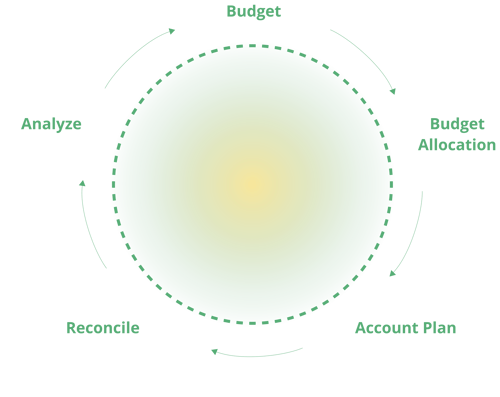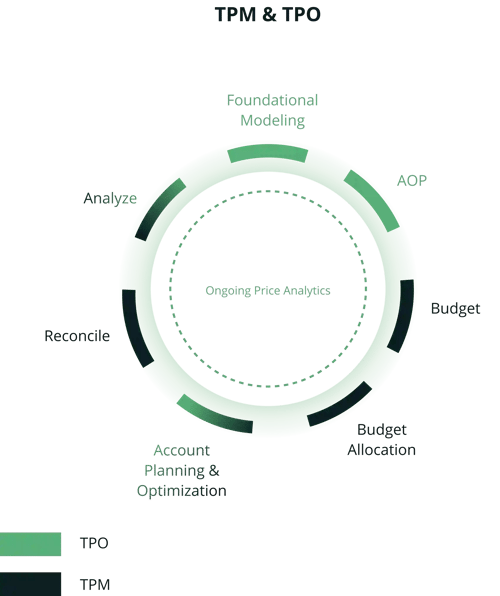How to Implement Trade Promotion Management Software At Your CPG Company
Discover key steps to successfully implement Trade Promotion Management (TPM) software for more efficient trade promotions in your CPG company.
Master the world of trade promotions! Learn what really distinguishes TPO from TPM and make your trade spend work harder!
In the consumer packaged goods (CPG) industry, confusing acronyms like TPM, TPO, TPx, and RGM are common, especially in discussions around trade management. But what exactly sets these terms apart? Today, we will delve into the distinctions between trade promotion management (TPM) and trade promotion optimization (TPO), crucial terms to understand if you're venturing into the trade and CPG sectors.
For a great resource for industry abbreviations and acronyms, consider downloading our all-inclusive acronym guide.
In summary, TPM and TPO are components of TPx, with the primary difference lying in their focus areas - TPM is more transactional, while TPO is more analytic. However, this explanation is quite rudimentary.
Let's investigate the specifics for a clearer picture.
TPM comprises a range of tasks that revolve around analyzing, budgeting, planning, and aligning a company's trade expenditures. The main aim is to increase sales and profitability while simultaneously improving the productivity of the sales and finance teams, have accurate accruals of financial liability, and ensure that trade spend is validated and deductions are cleared quickly.
TPM involves a systematic process encompassing several stages, or components, each playing a vital role in the overall promotion performance and success. The graphic below illustrates the typical TPM cycle:

Understanding and managing these components effectively can increase productivity, help to grow sales, improve profitability, and enhance retailer relationships.
One of the great outcomes of maintaining a strong discipline around TPM, is ensuring the integrity of your financials, from financial plans, accruals through to actuals - getting it all lined up, accurate and flowing to the right GL accounts, all integrated into the right internal systems. For more information on how TPM solutions should help ensure financial accuracy, read our blog here.
While many companies still manage TPM in spreadsheets, as a business grows, that becomes increasingly difficult. A strong TPM software solution can help automate trade tasks like promotion creation, approvals, and deduction management while providing the right information to make smarter decisions.
Read about the most important features of a TPM software provider here: Top 5 Capabilities to Look for in a Trade Promotion Management (TPM) Software
CPGvision has many added advantages, including the ability for in-app, cross-functional collaboration so everyone is consistently operating from one source of truth and all communication remains part of the correct records, and the utilization of artificial intelligence (AI) to generate more accurate, holistic forecasts. Ultimately, the entire system provides a strong payout through improved return on investment (ROI), trade spend, and significant productivity gains. CPGvision is considered to be the strongest combination of functionality and ease of use among TPMs.
TPO stands apart from TPM by virtue of its emphasis on predictive analytics. It leverages AI technologies to recommend more efficient promotions and employs scenario modeling to formulate plans with a higher probability of achieving the set objectives.
Read about the benefits of TPO here: The Top 10 Benefits of TPO for Manufacturers & Retailers

In short, the answer is yes; there can be. Generally, analytics incorporated into TPM tend to be more focused on telling us what happened, and TPO is more focused on telling us what will or could happen. Prescriptive TPO takes this one step further, offering the user suggested changes to help their promotions and plans meet their goals.
CPGvision employs a very robust guardrail system to ensure that the plans that are generated are realistic and meet the rules of both the manufacturer and retailer, this is called constraint based optimization and is crucial in any TPO. The graphic below illustrates the business cycle for TPM and TPO working together.
When using the CPGvision platform, we do incorporate predictive analytics into TPM as well. This really helps to generate reliable, holistic forecasts within TPM. Users can indeed formulate predictions and strategies within TPM, but the system is not inherently designed to suggest plan optimization - this is where the utility of TPO becomes important.
Certain companies may label their offerings as TPO solutions when, in fact, they're merely simple analytics typically found within a robust TPM system.
When assessing TPO systems, stay alert and avoid getting misguided.
Merely generating base and uplift factors or creating ROI dashboards doesn't necessarily qualify a system as TPO - these functionalities are, interestingly, an integral part of CPGvision's TPM.
Read about the importance of TPO analytics here: How TPO Analytics and Data-Driven Insights Can Revolutionize Trade Promotions
We’ve even seen a vendor claim this as a difference:
‘In TPM, the product dimension/lens you are most likely to see is case sales (shipments) for your product portfolio. In TPO, cases/shipments remain in the picture, but units and consumption (point of sale/POS) data are added to the mix.’
Hold on a second.
From our perspective, a competent TPM system should have the capability to process and harmonize cases, units, sales, and profit data, regardless of whether it's sell-in (shipments), sell-through (distributor), or sell-out (POS) data. Having this feature doesn't automatically categorize a system as TPO!
Let's look at another distinguishing element suggested by our competitors:
They claim that ‘sales forecasting in TPM - typically baseline and promotional shipment estimates - is a manual process. Planners use historical data management, sales, past promotion results, etc., to decide what the forecast should be.’
Huh? Shouldn’t a good TPM system enable predictive forecasts? If your TPM is built on the right foundational modeling, like CPGvision, it will!
While TPO can be managed without specific software, it can be challenging to handle, lacking in granularity, and may be difficult to integrate into a transactional TPM tool. When considering TPO solutions, look for powerful software capable of handling and managing tasks efficiently on an ongoing basis!
Read about How to Elevate Your Trading Strategy with TPO Software here.
A true prescriptive and predictive TPO system must utilize machine learning (ML) models and AI to:
There are many TPM solutions on the market, complemented by an equally vast, if not greater, array of TPO solutions. The optimal approach is a seamlessly integrated solution that allows your TPM and TPO to collaborate on a single platform, within a unified user interface, fostering true integration.
Such a unified approach not only simplifies the management of trade promotions but also leverages the power of predictive analytics to guide strategic decisions, bridging the gap between tactical execution and strategic planning and is a strong factor in user adoption.
Here at CPGvision, we believe in the transformative potential of integrated TPx solutions for consumer goods companies, and we're committed to helping organizations unlock this potential.
To see how our powerful TPM and true TPO can help your business, please contact us for a demo of our comprehensive platform.
Discover key steps to successfully implement Trade Promotion Management (TPM) software for more efficient trade promotions in your CPG company.
Effective RGM requires tight financial control over your trade budget. Maintain financial integrity when integrating TPM with ERP systems.
Discover the critical role of TPM software in CPG companies to track, analyze, and optimize your trade promotion activities for maximum returns.